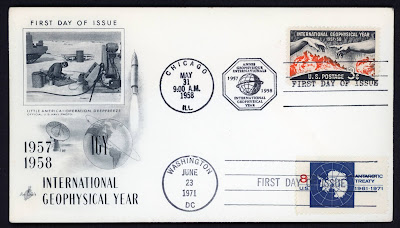I recently purchased two covers with themes of U.S. earthquakes, so I thought I'd highlight them today.
Yesterday there was a significant (magnitude 6.9) earthquake in Croatia, near the capital of Zagreb. I used to teach about earthquakes and seismology in my geophysics courses at Franklin & Marshall College. I set up and was in charge of an earthquake seismograph, which in recent years has evolved into a station managed by the Lamont-Doherty Seismographic Network. In the early years of cooperation with Lamont, I started and maintained a blog about earthquakes and seismology, The Shaking Earth (still up, but inactive).
 |
| Cover commemorating the 1964 Great Alaskan Earthquake |
One cover I bought was prepared by the Anchorage Philatelic Society after the Easter Sunday Alaska earthquake of March 27, 1964, which occurred less than two months before the Anchorage Stamp Show (APEX). The magnitude 9.2 Anchorage earthquake remains the most powerful earthquake recorded in North American history, and the second most powerful earthquake recorded in world history (after the 1960 Chilean temblor). The cover features the Red Cross Centenary issue stamp (Scott #1239), an Anchorage cancel, and the Apex cachet.
The second souvenir cover has a cachet of the Loma Prieta earthquake and a pictorial cancellation of the flag stamp (Scott #2280). The quake of Oct. 17, 1989, with an epicenter near Santa Cruz, California, ironically occurred immediately before a scheduled World Series game between the San Francisco Giants and the Oakland A's. The magnitude of 6.9 was about 1000 times less energetic than the Alaskan earthquake, but caused significant damage ($5 billion worth) in the major metropolitan Bay Area. It was the second costliest earthquake in U.S. history, behind only the 1994 San Fernando earthquake ($30 billion of damage) in the Los Angeles area.
 |
| Cover commemorating the 1989 Loma Prieta Earthquake |
For more information on these and other earthquakes, the U.S. Geological Survey hosts a number of informative web pages.
Recall that number 12 on the list of the 14 special areas of IGY inquiry was seismology, which includes the study of earthquakes. More on seismology and the IGY in posts to come.





























